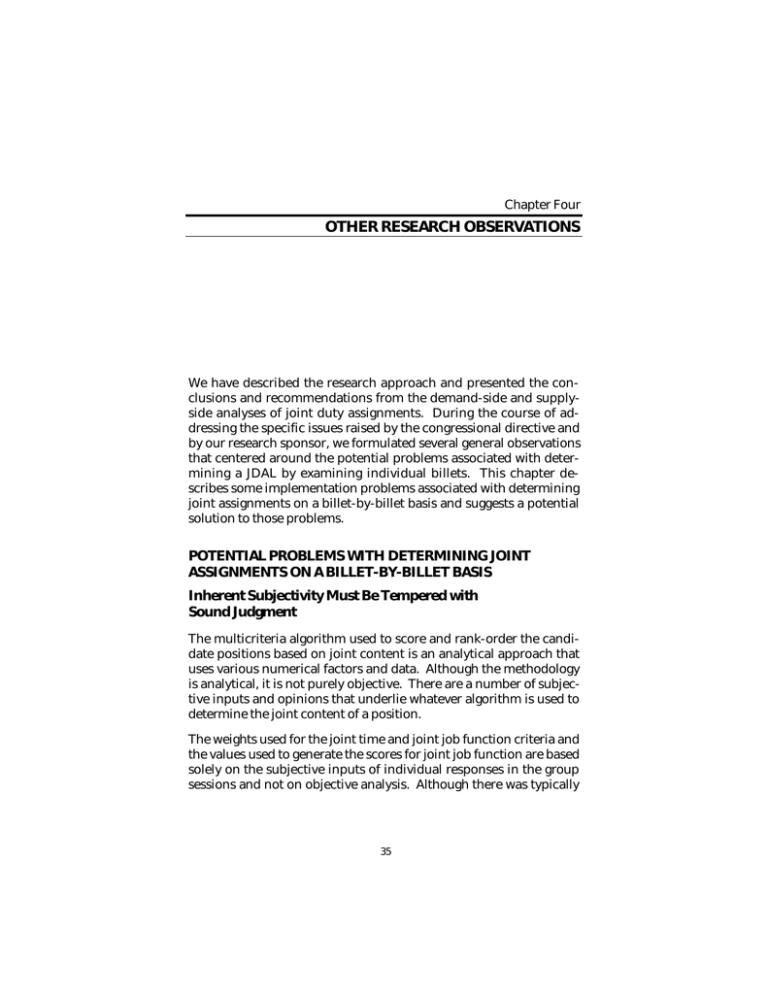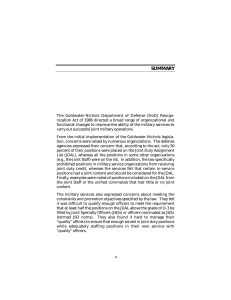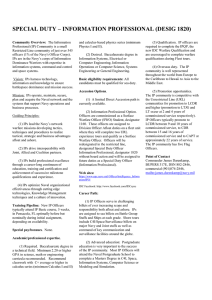OTHER RESEARCH OBSERVATIONS
advertisement

Chapter Four OTHER RESEARCH OBSERVATIONS We have described the research approach and presented the conclusions and recommendations from the demand-side and supplyside analyses of joint duty assignments. During the course of addressing the specific issues raised by the congressional directive and by our research sponsor, we formulated several general observations that centered around the potential problems associated with determining a JDAL by examining individual billets. This chapter describes some implementation problems associated with determining joint assignments on a billet-by-billet basis and suggests a potential solution to those problems. POTENTIAL PROBLEMS WITH DETERMINING JOINT ASSIGNMENTS ON A BILLET-BY-BILLET BASIS Inherent Subjectivity Must Be Tempered with Sound Judgment The multicriteria algorithm used to score and rank-order the candidate positions based on joint content is an analytical approach that uses various numerical factors and data. Although the methodology is analytical, it is not purely objective. There are a number of subjective inputs and opinions that underlie whatever algorithm is used to determine the joint content of a position. The weights used for the joint time and joint job function criteria and the values used to generate the scores for joint job function are based solely on the subjective inputs of individual responses in the group sessions and not on objective analysis. Although there was typically 35 36 Identifying and Supporting Joint Duty Assignments: Executive Summary a consensus on the relative ordering of the criteria, there was a degree of variability in the specific weights and values for some of the measures. There is also the issue of the data from the survey instruments. We asked respondents to spread their time across several dimensions— to various functional duties, to a range of subject areas, and to matters involving multiple services, or nations, or their own service or organization. There is a degree of subjectivity in the responses, and, therefore, in the data we use to generate joint scores.1 In addition to some degree of subjectivity in the responses, there is the possibility that the objective of a question may have been misunderstood by the respondent. Although we tested the various questions with pretests and a pilot survey, some respondents may still have perceived some ambiguity to the questions. Finally, approximately 15 percent of the surveys were never returned. Therefore, we were not able to generate joint content scores or make an ultimate decision on a large number of positions. Because of the various sources of subjectivity, the results of the algorithm should not be viewed as “the answer.” Rather, the scores and rankings produced by the joint time/joint function algorithm are a starting point for determining which positions should receive joint credit. The data and the algorithm can indicate the obvious; that is, those positions that should definitely be on, or not on, a new JDAL. There will be, however, a number of positions around the “cut line” that will require closer examination. The disposition of those billets that are within approximately 5 to 10 percent of the minimum score that would qualify for joint credit, in addition to those positions for which data are not available, should be determined by comparison with like positions within the same organization or similar billets at other organizations. There should be a consistency in the determination of a new JDAL, a consistency that will not come purely from the algorithmic process. Also, the ______________ 1 In most cases, the person filling the position provided the data. However, in approx- imately 20 percent of the cases, the position was not occupied at the time of the survey. In those situations, a supervisor or someone else responded to the survey. This, of course, adds another layer of subjectivity to the data associated with those positions. Other Research Observations 37 commander of an organization should have some input regarding which of his organization’s positions should be granted joint credit. Although the analytical process and the precision implied by the numbers is appealing, the results must be tempered by sound judgment. Dynamics of the Personnel World Will Require Periodic Updates The personnel world is very dynamic, especially in these times of force structure changes and reassignments of functional responsibilities across organizations. Billets are constantly added to or deleted from organizational structures. Existing billets may have new duties and responsibilities assigned, either because a new supervisor decides changes are needed or because the organization has taken on new functional duties. These dynamics will require periodic updating, through a survey and recalculation of joint content scores, of the JDAL. Such updates would be time consuming and costly. If the size of the JDAL is held fairly constant, the periodic updates could cause turmoil in the joint assignment world. Some billets that are on a JDAL may fall off through the updating process. Or the opposite may occur. Decisions will be necessary on how to award joint credit for the individuals assigned to such billets. Also, the potential for changing the joint status of a position will create a new set of problems for service personnel managers who must attempt to ensure that an adequate number of quality officers are assigned to the joint world and that all quality officers receive a joint assignment to qualify for promotion to general/flag officer. During our various interviews, we often heard concern about the morale problems that potentially exist in “split organizations”— those organizations where some, but not all, of the positions are on the JDAL.2 Using the joint time/joint job function algorithm to determine joint duty assignments on a billet-by-billet basis could make ______________ 2 Of those officers who responded, 66 percent either agreed or strongly agreed that morale problems will exist if joint duty credit is awarded for some but not all positions in their organization. See MR-574-JS, Who Is Joint? Reevaluating the Joint Duty Assignment List, for an overview of the responses to the survey’s opinion questions. 38 Identifying and Supporting Joint Duty Assignments: Executive Summary the problem worse by creating more “split organizations.” The analysis results suggest there will be no organizations in which all the candidate billets receive joint credit.3 POTENTIAL SOLUTION TO IMPLEMENTATION PROBLEMS: GRANT JOINT CREDIT TO ALL BILLETS AT JOINT ORGANIZATIONS One real advantage of the current implementation of GoldwaterNichols is its simplicity, especially in light of billet dynamics. For the “100 percent” organizations, any billet at the grade of O-4 or higher receives joint credit, regardless of changes in the organization’s billet structure or in individual billet responsibilities. For the “50 percent” organizations, the individual organizations decide which half of their billets will be on the JDAL. Morale problems may exist, but they are limited to a subset of all joint organizations. A potential solution to implementation problems is to base a new JDAL on a more liberal interpretation of the current philosophy. The results of our analysis suggest that almost all billets have some joint content. A policy decision could state that all billets (at and above a specified grade) in joint organizations qualify for joint credit. Such a policy has a number of potential advantages and disadvantages. On the plus side, granting joint credit to all candidate billets in joint organizations would be simple to implement. The dynamic changes in the personnel world would not create a problem, and morale problems with “split organizations” would be eliminated. Further more, more officers could attain their joint tour prerequisite for promotion to general/flag officer. On the down side, services may not be able to support a JDAL based on such a policy. Our supply-side analysis suggests that the services, with current personnel policies and joint training allocations, could support approximately 9900 joint positions above the grade of O-3. Of the 15,000 candidate billets we surveyed, approximately 12,600 ______________ 3 A policy decision may stipulate that all of an organization’s billets be on the JDAL if the percentage of the organization’s billets that qualify through the algorithmic process is high. However, a decision would be needed on the appropriate “cut off” percentage. Other Research Observations 39 are above the grade of O-3 (and 1584 are in-service billets). Figure 4.1 shows that with small changes to law and policy, the services could support a much larger list. The bottom line on Figure 4.1 represents the same line shown in Figure 3.5, which reflects the 9900 JDAL with an 83 percent assignment policy and the current maximum JPME throughput of 1089. The next line shows that the maximum supportable JDAL above the grade of O-3 (again, assuming the 83 percent assignment policy) could increase to approximately 10,600 if JPME throughput increased by 150 quotas.4 Moreover, the maximum supportable JDAL could be increased even further by changing the law to increase the percentage of COS AA AAAAAAAAAAAAA AAAAAAAAAAAAA AAAAAAAAAAAAA AAAAAAAAAAAAA RANDMR622-4.1 15% COS & 40% fill 25,000 40% fill (JSO & nom) 20% COS exception 20,000 +250 JPME Maximum JDAL Current 1089 JPME 15,000 Billets above O-3 Base case 10,000 5,000 0 0 17 34 50 67 83 100 Percentage of JPME graduates assigned to JDAs Figure 4.1—Effect of Law/Policy Changes on Size of Supportable JDAL ______________ 4 This might be accomplished by some combination of increasing AFSC throughput to the originally planned level and granting JPME credit to alternative military education. 40 Identifying and Supporting Joint Duty Assignments: Executive Summary Exceptions and to decrease the 50 percent requirement of JSOs and JSO noms in JDAs. The impact of these potential changes is shown in the remaining lines in Figure 4.1. Specifically (assuming the 83 percent assignment policy), if the COS Exceptions were 20 percent instead of 12.5 percent, the maximum supportable list could increase to 12,369; if the 50 percent rule were changed to a 40 percent rule, the list could increase to 13,501; and if COS Exceptions were 20 percent and there were a 40 percent rule, the list could increase to 18,558. A larger JDAL would increase the personnel management burden associated with the Goldwater-Nichols promotion objectives, although the changes suggested in Chapter Three should help alleviate that burden. Further, the services must recognize that the law does not specify that all joint officers must be promoted, only that officers who are likely to be promoted be shared between the joint and service worlds. A larger issue is whether “being joint” is weakened by broadening the rules for granting joint duty credit. A small percentage of the survey respondents had low joint content scores because they spent little or no time on joint matters.5 Rather than being concerned that positions with low joint content scores are being awarded joint credit, the real question is why there are positions in joint organizations that seem to be devoted to purely service issues. Senior leaders at the joint organizations should examine such positions and try to strengthen their joint content rather than eliminating them from joint duty consideration. Finally, efforts should be made to reduce the number of positions at the joint organizations. In a period when the overall force structure is being drastically reduced, almost all joint organizations are experiencing an increase in the number of assigned officers. Since the first JDAL was published in 1987, it has increased by over 10 percent. Much of the increase is associated with the defense agencies, where every two new positions represent an increase of one position on the JDAL. Of the officers who responded, 24 percent either agreed or ______________ 5 Low joint content scores can also result from the type of work a person performs when dealing with joint matters. Certain functional duties, such as administrative, and certain subject areas, such as legal affairs or public affairs, were assigned very low values by the participants at the group sessions. Other Research Observations 41 strongly agreed with the statement that the duties and responsibilities of their billet could be performed just as effectively by a civilian. In the defense agencies, 34 percent of the respondents felt that a civilian could adequately perform the billet functions. Granting joint duty credit to all officers at joint organizations would be a major cultural change for the services. But it would greatly simplify implementation procedures while increasing overall morale. An interim position between examining individual billets and granting joint credit to all positions is to define the JDAL on the basis of suborganizations. That is, the implementation procedures could focus on the appropriate suborganizational level within each joint organization. Each suborganization would either have all or none of its billets placed on the JDAL. The decision would be based on the analysis of the survey responses, inputs from the commanders of the organizations, and the perceived “value” of different functional duties and subject areas in contributing to a significant joint experience. Such an implementation approach would be simple while reducing the morale problems caused by “split” organizations.





